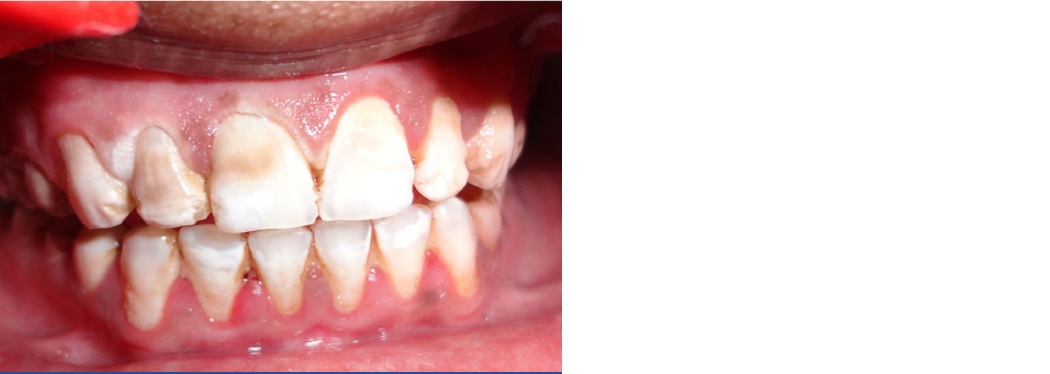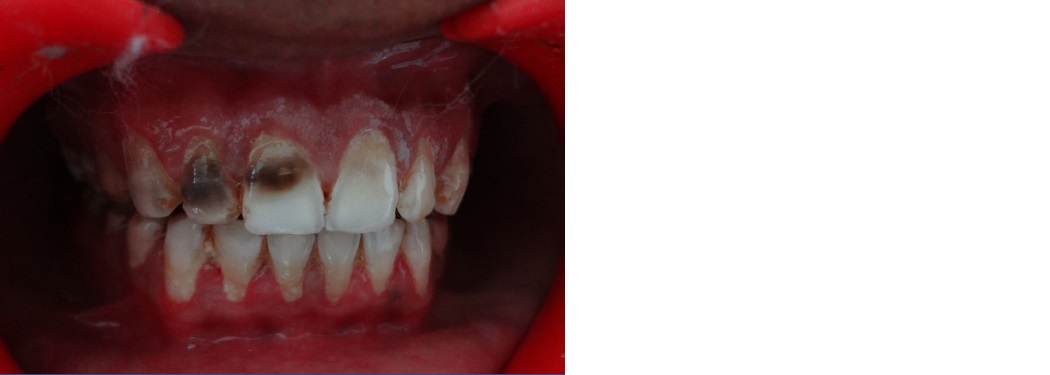Can Accidental Local Application of A Drug Cause Discolouration of Permanent Teeth?
Manoj Kumar Hans1, Ajay Nagpal2, Shashit Shetty3, Rinki Hans4
1Associate Professor, Department of Conservative Dentistry & EndodonticsVyas Dental College & Hosptal,, Jodhpur, Rajasthan, India.
2 Associate Professor, Department of Conservative Dentistry & EndodonticsKanti Devi Dental College and Hospital,, India.
3Professor & Head, Department of Conservative Dentistry & Endodontics,Kanti Devi Dental College and Hospital,, Jodhpur, Rajasthan, India.
4Post Graduate Student, Department of Public Health Dentistry,Vyas Dental College & Hosptal, India.
NAME, ADDRESS, E-MAIL ID OF THE CORRESPONDING AUTHOR: Dr. Manoj Kumar Hans,Vyas Dental College and Hospital, Near Kudi Haud, Pali Road, Jodhpur, Rajasthan-342005, India.
Phone: 91-9829779528,
E-mail:hansie51@yahoo.com
Thorough knowledge on the aetiology of tooth staining is of importance to dental surgeons, in order to enable a correct diagnosis to be made when examining a discoloured dentition and it allows the dental practitioner to explain to the patient the exact nature of the condition. Tetracyclines are a group of drugs which can discolour teeth permanently. One such case of discolouration of adult teeth caused by administration of tetracycline(oxytetracycline) has been reported here and it has been discussed in detail.
Discolouration, Aetiology, Intrinsic, Staining, Tetracycline
Case report
A 20-year-old male patient reported to Dental Outpatients Department with chief complaint of discolouration in upper front teeth since past one month. On clinical examination, bluish grey discolouration was noticed on maxillary right central and lateral incisors [Table/Fig-1]. Oral hygiene was poor and generalized fluorosis was present. Patient gave history of oral ulceration in labial mucosa in relation to maxillary right central and lateral incisors. Patient was advised local application of Terramycin (oxytetracycline) 250mg, once a day for fifteen days for oral ulceration by some dental quack. Patient used to open the capsule of Terramycin and apply the ingredients on the oral ulceration directly. During local application of the drug, ingredients used to fall on maxillary teeth in that region. Patient started noticing discolouration of teeth within fifteen days of drug application. Initially, discolouration was light yellow in colour and gradually, it became bluish grey. No history of trauma was reported. Family history was non-contributory. Maxillary right central and lateral incisors elicited positive response to thermal as well as electric pulp testing. Based on subjective and objective findings, a diagnosis of extrinsic discolouration in maxillary right central and lateral incisors caused by local drug application (terramycin) was made and patient was advised bleaching/veneering in maxillary right central and lateral incisors. Vital bleaching with Polaoffice kit (SDI, Brunsdon St,Victoria, Australia) was done on right maxillary central and lateral incisors in a single sitting [Table/Fig-2]. Patient was recalled for the second sitting of vital bleaching but refused to come for treatment, as he was happy with outcome of first sitting treatment.
Clinical image showing extrinsic discoloration in maxillary right central and lateral incisors

Clinical image showing post-operative results in maxillary right central and lateral incisors after bleaching

Discussion
Tetracyclines are a group of broad-spectrum antibiotics originally found in Streptomyces bacteria and used for treating many common infections. When administered after the second trimester of pregnancy through the age of 12 years (the period during which permanent teeth are still forming), the antibiotic is deposited within these forming teeth and intrinsic staining may result [1]. The period of dental formation during which teeth are most vulnerable to tetracycline staining, is from the fourth month in utero through the fifth month postpartum[2].
In addition to developing foetuses and children under age of 13 years, infants of breast-feeding mothers in whom the drug is administered can be affected [3]. When the drug is administered in courses, discolouration is generalized and band-like; extended use results in a more homogeneous appearance. Different tetracyclines result in different colour effects [4]. Colour tends to become browner with sun (ultraviolet) exposure, with anterior teeth being more susceptible to light-induced colour changes than posterior teeth.
The role of tetracycline in tooth discolouration has been well documented [5]. Tetracycline tooth discolouration is of tremendous aesthetic concern to patients [6]. The occurrence of tetracycline tooth discolouration can affect adult dentition, following prolonged administration of tetracycline or its minocycline derivative [5].
Due to their deposition in actively calcifying teeth and bones, tetracyclines are contraindicated in pregnant females and in children who are less than eight years of age [7]. Their use during development of dentine and enamel may cause permanent yellowbrown discolouration of teeth and hypoplasia of enamel [7]. The discolouration varies with the specific tetracycline congener, the duration of therapy, the dosage of offending agent, the number of separate treatment courses, the concurrent activity of calcification and the proximity of the deposits to dentino-enamel junction [7,8].
Types of staining caused by different types of Tetracycline group of drugs [9]
Chlortetracycline (Aureomycin): Gray brown.
Dimethylchlortetracycline (Ledermycin): Yellow staining.
Doxycycline (Vibramycin): Does not cause staining.
Oxytetracycline (Terramycin): Yellow staining.
Tetracycline (Achromycin): Yellow staining.
Minocycline: Black.
Tetracycline-induced discolouration in developing deciduous teeth results from the formation of insoluble tetracycline-calcium orthophosphate complexes which are deposited in dentine and enamel and which darken upon exposure to light [8].
The relative lack of free calcium protects the erupted permanent adult dentition against tetracycline hydrochloride-induced tooth discolouration. However, green-grey or blue-grey staining of previously normal coloured and fully mineralized permanent adult teeth, as a complication of long-term minocycline or doxycycline therapy, has been documented [10,11]. The discolouration may develop as early as one month after initiation of therapy and it affects 3-6 per cent of patients receiving minocycline at doses greater than 100mg/day [10,11]. Vital bleaching and composite/porcelain veneers/crowns remain the best possible therapeutic approaches for staining of permanent dentition by tetracycline analogues. The discolouration which had developed in this case may have been caused by deposition of oxytetracycline in close proximity to the dentino-enamel junction. In the present case, bluish-grey discolouration of involved teeth was noticed, because patient was farmer by occupation. Yellowish stains caused by oxytetracycline changed to bluish-grey due to exposure to sunlight.
The Government of India vide notifications published in the Gazette of India vide G.S.R. No. 322 (E) dt 03-05-1984 have prohibited the manufacture, sale and distribution of oxytetracycline liquid oral preparations, but this drug has not been banned in tablet form and is freely available over the counter. Although each drug should be prescribed after weighing its therapeutic and side effects, quacks prescribe drugs without this knowledge.
As various derivatives of tetracycline can cause tooth staining, dental clinicians as well as physicians must be aware of this side effect, so that they can monitor it and either adjust the doses of tetracycline derivative or give some safer alternative. Hence, staining of the teeth can be prevented at early stages only.
Conclusion
Teeth can get discoloured due to various factors, both intrinsic and extrinsic. The correct diagnosis for the cause of discolouration is important, as, invariably, it has a profound effect on treatment outcomes. It would seem reasonable, therefore, that dental practitioners have an understanding of the aetiology of tooth discolouration, in order to make a diagnosis and for enabling the appropriate treatment to be carried out. Patients should be warned of a medication’s potential to stain teeth and when possible, they should be offered a safer alternative or be told as to how to minimize the staining.
[1]. SQ Cohlan, Tetracycline staining of teethTeratology 1977 15:127-29. [Google Scholar]
[2]. A Watts, M Addy, Tooth discolouration and staining: A review of the literatureBr Dent J 2001 190:309-16. [Google Scholar]
[3]. MT Genot, HP Golan, PJ Porter, EH Kass, Effect of administration of tetracycline in pregnancy on the primary dentition of the offspringJ Oral Med 1970 25:75-79. [Google Scholar]
[4]. JM Moffitt, RO Cooley, NH Olsen, JJ Hefferren, Prediction of tetracycline-induced tooth discoloration.J Am Dent Assoc 1974 88:547-52. [Google Scholar]
[5]. CC Cheek, HO Heymann, Dental and oral discolorations associated with minocycline and other tetracycline analogsJ Esthet Dent 1999 11:43-48. [Google Scholar]
[6]. RS Fieldler, RB Reichl, Combined professional and home care night guard bleaching of tetracycline stained teethGen Dent 2000 48:257-61. [Google Scholar]
[7]. AK Shetty, Tetracyclines in pediatrics revisitedClin Pediatr 2002 41:203-09. [Google Scholar]
[8]. AS Kashyap, HS Sharma, Discolouration of permanent teeth and enamel hypoplasia due to tetracycline.Postgrad Med J 1999 :75-772. [Google Scholar]
[9]. PA Hayes, C Full, J Pinkham, The etiology and treatment of intrinsic discolorationsJ Can Dent Assoc 1986 52:217-20. [Google Scholar]
[10]. L Ayangco, PJ Sheridan, Minocycline-induced staining of torus palatinus and alveolar boneJ Periodontol 2003 74:669-71. [Google Scholar]
[11]. A Auluck, MS Thomas, M Kundabala, Chlorodontia Sumanth K N, Minocycline induced staining of permanent dentition - a case reportJ Conserv Dent 2007 10:89-92. [Google Scholar]